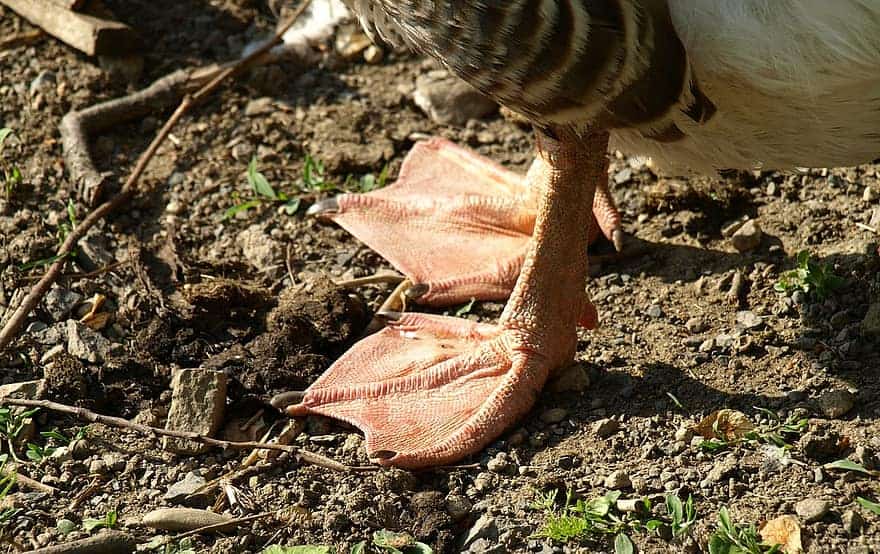
Updated September 8, 2020
Just like the nails on your hands and feet, geeseUnless explicitly mentioned, we are referring to domesticated goose breeds, not wild geese, who may have unique needs not covered by this resource. have nails sheathed in keratin on their feet. And just like us, this consistently growing material needs to be maintained for their health. A gooseUnless explicitly mentioned, we are referring to domesticated goose breeds, not wild geese, who may have unique needs not covered by this resource. in a sanctuary environment of frequent straw and dirt underfoot may not have enough rough surfaces to naturally wear down their nails, so you should plan to assess their nail length every time you conduct a goose health examination, but only trim their nails when necessary.
Signs You Should Step In
You should schedule a trimming if a goose’s toenails grow to the length where they begin to grow far past their feet, become dangerously sharp, begin to curl, or become ingrown (sometimes in circumstances where they don’t have enough hard surfaces to scratch against, sometimes by virtue of their genetics).
If at all possible, have a veterinarian or expert give you hands-on training for this procedure! There are nuances in trimming techniques that can not be conveyed through words alone.
Pre-Trimming Suggestions
Carefully corral and pick up the goose. If they’re too stressed to be held, you must set them down and give them time to calm down before trying again. This process may be aided with a second set of helping hands holding the goose if you or the bird are nervous!
Consider setting out all of your supplies in an easily-accessible area so you can get the work done quickly!
How To Trim A Goose’s Nails

Trimming a goose’s nails is very similar to trimming a cat’s or dog’s nails. Like cats and dogs, geese also have a sensitive area made of soft tissue in the center of their claws known as the quick. Unfortunately, some goose nails tend to be dark, making it hard to identify where the quick begins. Cutting the quick by accident can be painful and bloody, so it’s important to be very mindful about how much you trim.
You can make the process of nail trimming easier by soaking their feet in warm water or cleaning them thoroughly with a damp rag prior to trimming. Soaking softens the nails which makes them much easier to clip without the nail splitting. Clean toes also make the quick much easier to identify!
Gently rotate the bird onto their side if they aren’t too big that rotation would cause undue stress or respiratory distress. Cradle the goose into your arm to keep their wings secure. They should calm down a bit after some secure, gentle holding. If by yourself, use one hand to hold their foot and the other to do the trimming. Secure their foot with your thumb and forefinger to hold it still. They might be touchy- this isn’t out of pain but because of distaste towards their feet being touched.
Using a cleaned pair of pet or human toenail clippers, trim a very small amount of the goose’s nails at a time to prevent accidental quick cutting. Each time you snip, take a look at the remaining nail. If it changes hue even slightly, you’re very close to the quick and should stop trimming. If the nail is still too long and you’re near the quick (as it grows and recedes depending on overall nail length), you can wait a few weeks for the quick to retreat and then trim a little more, repeating the process of trimming and waiting until their nails reach a safe length.
In some instances, after you’ve trimmed the nails you may need to file down the remaining rough edges with an emery board or nail file to protect the goose from injuring themselves when they scratch. Make sure to clean nail clippers if they become dirty or come into contact with blood from hitting the quick before using them to trim another individual’s nails.
If You Draw Blood
If you accidentally draw blood, apply an astringent like a styptic pencil, styptic powder (such as Quick Stop), alum, or witch hazel. You can also dip the wound in cornstarch or flour to encourage natural clotting. Lacking these tools, you can also use a piece of toilet paper as if you’d nicked yourself shaving! If the bleeding doesn’t stop, you can use the tip of your finger to apply pressure for up to a minute and repeating until any bleeding ends. If you’re going to return a goose with a nicked quick to the flock, be sure to wait until the blood is definitely stopped and cleaned as birds sometimes like to bully flockmates who have open wounds.
Once you’ve managed a few geese’s nails, you’ll be a proud poultry pedicure provider in no time!
SOURCES:
Care Of Beak, Nails, Spurs | University of California At Davis
Trimming Your Chicken’s Nails | Backyard Chickens (Non-Compassionate Source)
How To Trim Chicken’s Toenails | Tilly’s Nest (Non-Compassionate Source)
Trimming Chicken Beaks, Claws, & Spurs | Countryside Network (Non-Compassionate Source)
If a source includes the (Non-Compassionate Source) tag, it means that we do not endorse that particular source’s views about animals, even if some of their insights are valuable from a care perspective. See a more detailed explanation here.








